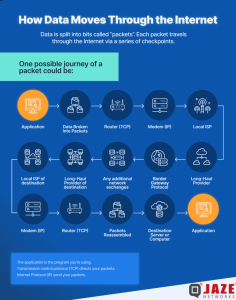





Most ISPs today are offering 100 Mbps bandwidth and some ISPs are now starting to offer even upto 1 Gbps. How much bandwidth does a typical household need for current and future requirements?
The Infographic below shows how the Internet has become the most significant factor of modern homes. With development of new technologies every member in the household has multiple electronic devices which need access to Internet like Smartphones, laptop, TVs, Smart home devices, watches, etc. Broadband technologies are developing rapidly, and with the emergence of a new technologies like FTTH based on GPON it is easier to deliver consistent bandwidth for broadband delivery.
The number of connected devices and applications have increased requiring more bandwidth everyday. Also demand for IPTV, OTT and VoD services has increased bandwidth requirements tremendously. Even though 10 Mbps is more than sufficient for Internet browsing and even viewing HD videos, subscribers tend to choose 100Mbps+ plans with unlimited data and ISPs try to cater to the same by offering higher bandwidth plans even though utilization remains much lower than the data and bandwidth caps. Nowadays some subscribers are almost using 50% of their bandwidth on an average on a constant basis and this utilization pattern is only going upwards with more people working from home and consuming video content.
Jaze ISP management enables Internet Service Providers (ISPs) to scale out and manage growing subscriber bases centrally and provide managed QoS for building highly scalable networks in order to cater to the surging demand for Internet.

The infographic below shows the journey of data through the Internet in the form of packets also known as network packets. Data is split into bits called packets and each packet travels through the Internet via series of checkpoints as shown in the diagram and these packets are responsible for delivering high speed internet and they can travel through air or fiber containing the destination address and the request.
Internet relies on the hardware infrastructure. Whenever you transmit data via the Internet, that information can’t just go somewhere. Instead, it has to be broken down, directed, and reassembled through Servers, switches, and routers that make their part of the internet working as it should.
Is your Internet successfully routing traffic through servers located physically closer to you through peering or having to go all the way to the other side of the world? Routers make these routing decisions based on the routing table and find the server which helps serve the data faster with lower latency.
Shape, manage and route packets effectively and efficiently with Jaze ISP Manager with flexible RADIUS based policy management to deliver the most efficient and quality Internet experience to your subscribers.

The infographic below shows how we will access super-fast Internet in the coming future with speeds at up to one gigabit speed per second. With this remarkable speed of internet some technology changes need to be made by the Internet service providers, Cable operators and all software and hardware related to delivering Internet speed for homes. 5G and other high speed networks need to upgrade networks and scale up to deliver 1 gbps broadband connections. Typically speeds of 1Gb per second are achieved through full fiber, or a Fiber to The Premises (FTTP) connections.
ISPs plays major role with delivering gigabit speed internet to every home on the last mile and it is only possible if they adopt technologies like GPON and DOCSIS 3.1 which allows ISPs to transfer gigabit speed broadband on their networks. Once these upgrades are made every home will be able to access gigabit speed broadband.
In order to ensure 1Gbps Internet delivery and a quality Internet experience, ISPs need software to manage and monitor their network and have smooth operations. Jaze ISP Manager provides automation of end-to-end operations at scale with customer growth and increasing bandwidth demand.

Purchasing enterprise routers for ISPs and enterprise routers requires a great deal of planning to identify the set of features requires and the throughput requirements to decide upon the right model and interfaces. When it comes to home routers, it is usually just purchased online or off the shelf without much thought. Are all routers the same or would they differ in performance? The Infographic below shows what kind of features we need in home router to get a better broadband experience with more speed and better stability. A Router really plays a significant role in your home network and so it has to be chosen carefully. Any router will share your Internet connection amongst your computers and other networkable devices (Smartphone’s, tablets, and so on), but better models provide features that will enhance your network and its performance.
The features which need to be in your home router and should preferably be offered by the ISPs are Gigabit Internet ports, atleast Dual band wireless with 802.11ac, Signal stability and Wi-Fi coverage with beam forming technologies, Guest Network, Parental control, Easy to setup wizard and good after sales support. As shown in the Infographic 80% of the Internet you get is dependent on ISPs and 20% depends on what type of router you choose.
All of these provide an opportunity for Internet service providers to customize their Internet offerings and provide Wi-Fi routers or ONU devices with Wi-Fi access bundled with the Internet plan to ensure the best quality of Wi-Fi network and premium experience to end-users.
Jaze Networks enables ISPs to monitor OLTs and CPEs on their network from a single dashboard to provide complete visibility for better troubleshooting and providing better service to their subscribers.